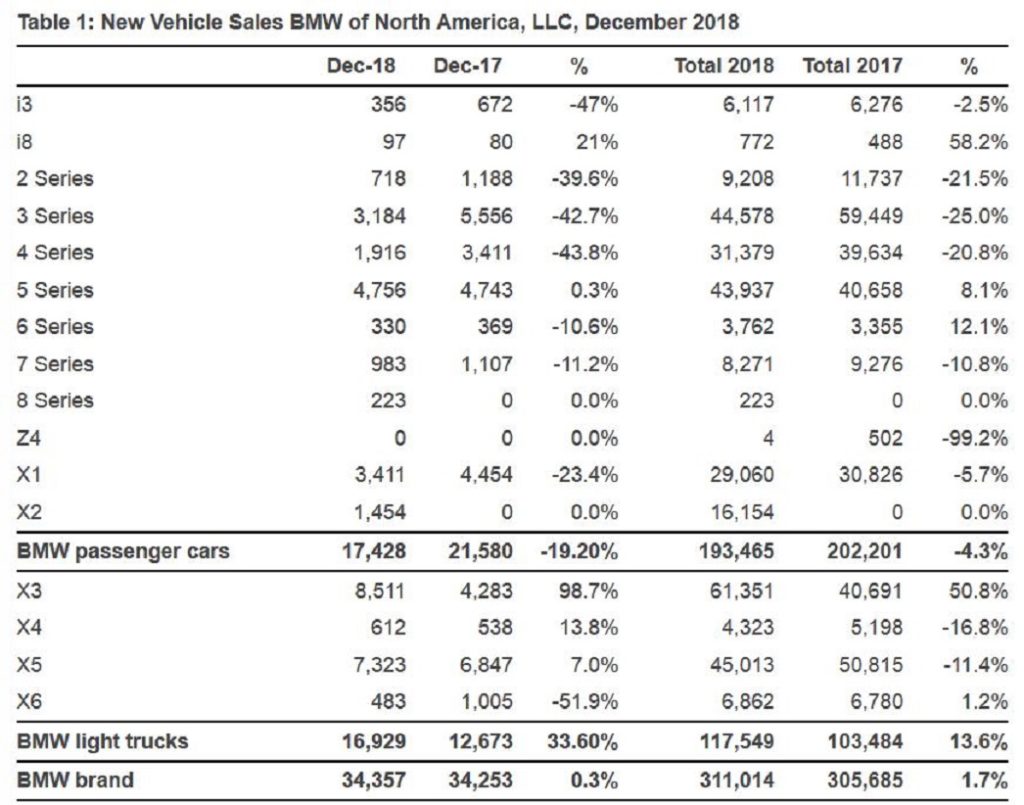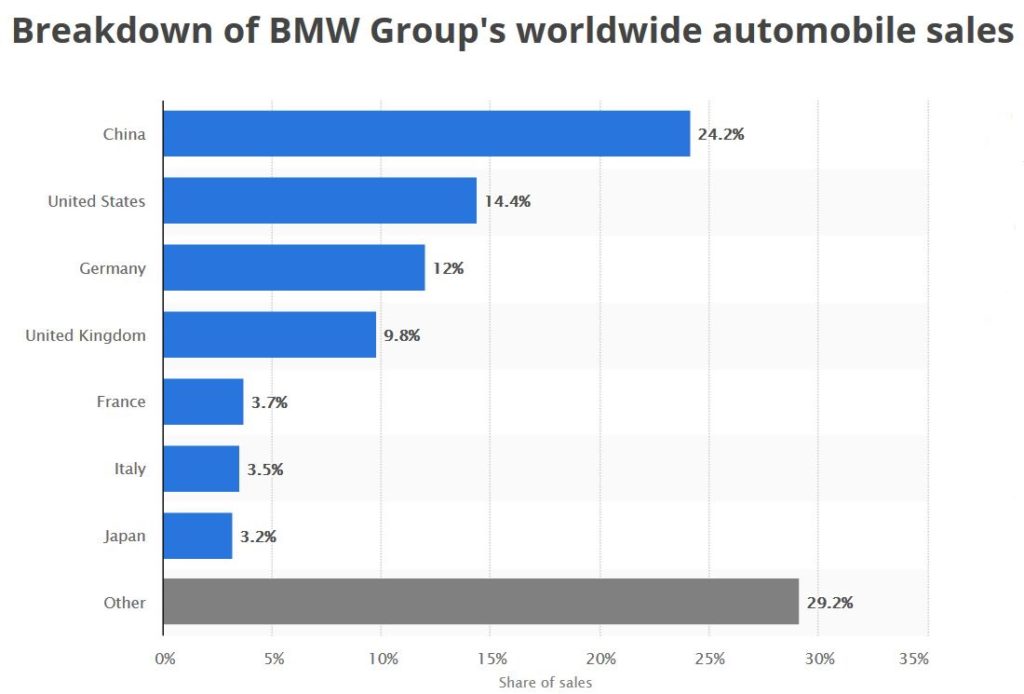
Happy New Year! With 2018 in the rear view mirror, how did BMW do in the North American luxury car market? In a year when its closest competitors were down in the market, BMW managed a sales gain of 1.7 percent in 2018, selling 311,014 vehicles. Overall the NA luxury market was down .3 percent.
Mercedes-Benz retained the #1 luxury market spot with 315,959 vehicles sold, despite 2018 sales being down 6.3 percent from 2017. 2018 BMW sales put them at #2, Lexus was #3 at 298,310 (down 2.2 percent), and Audi was #4 at 223,323 (down 1.4 percent). While not the focus of this post, the incredible success of the Telsa Model 3 should be mentioned.
It’s estimated that Tesla sold over 145,000 Model 3s in 2018, making it the most popular luxury car in the market. That’s somewhat ironic because the Model 3 was to be the model for “the masses” with a price tag around $35,000. But a price starting at $45,000 puts it into the luxury category. BMW’s average sale price was $55,047.
Turning to the sales number of specific BMW models, growth continues to be all about the SUVs. Or Sport Activity Vehicles (SAVs), as BMW prefers to call them. The introduction of the G01 generation X3 in 2018 propelled sales up 51.8 percent, and the X3 has been the best selling BMW for 10 consecutive months. A new version of the larger X5, code G05, should be arriving at dealerships very soon to replace the F15 generation. The new generation should help reinvigorate X5 sales, which were down 11.4 percent in 2018. And for the first time, an even larger X7 (G07) will be introduced in the first of 2019. Trucks overall were up 13.6 percent in 2018, and with two new model introductions 2019 growth should be even faster.
BMW cars were down 4.3 percent in 2018, with the large volume 3/4 Series down 25 and 20.8 percent, respectively. The new G20 3/4 Series did not reach dealerships in time to make a dent in these numbers. Also, the popularity of the G30 5-Series seems to be waning quickly. It was introduced in 2017 and increased sales that year by 25.5 percent, but growth in 2018 slowed to 8.1 percent.
There’s no question that much of this is due to the American desire for SUV and crossovers. But the shift has been swift and dramatic. For comparison, in 2013 BMW sold 252,278 cars. 2018 BMW sales were down to 193,465, a decline of more than 33 percent. Plus, that 2018 number includes the small X1 and X2 crossovers, which BMW classifies as cars.
The X2 did create a new model line for BMW, selling 16,154 vehicles in 2018. Though marketed at different demographic groups, there might have be some cannibalization from X1 sales. They were was down 5.7 percent in 2018, after being up 10.8 in 2017.
Certified Pre-Owned (CPO) sales were down 9.3 percent, but used 2018 BMW sales were up slightly overall:
 So what to make of 2018? First, while again not the focus here, the success of the Model 3 is a wake up call to the entire market. BMW’s release put a positive spin on their electric offerings, but the difference in numbers is stark:
So what to make of 2018? First, while again not the focus here, the success of the Model 3 is a wake up call to the entire market. BMW’s release put a positive spin on their electric offerings, but the difference in numbers is stark:
“BMW brand sales of electric and plug-in hybrid electric vehicles totaled 2,774 in December 2018, an increase of 2.0 percent over the 2,720 sold in the same month a year ago. For the full year, combined sales of BMW Group (BMW and MINI) electrified vehicles exceeded 25,000 for the first time, and grew 17.9 percent in comparison with 2017.
BMW Group currently offers five electrified models in the U.S., including the BMW i3, BMW i8 and i8 Roadster, BMW 530e, BMW 740e, and MINI Countryman plug-in-hybrid electric vehicle. Plug-in hybrid versions of the all-new BMW X5 and the all-new BMW 3 Series have been announced and will begin sales in the U.S. at a future date.”
I’ve little interest in electric cars, preferring BMWs made in the early and mid aughts. But if anyone can figure out how to combine the best of electric with legacy car technology, it should be BMW.
It’s obvious a lot is riding on the new 3-Series, as has always been the case with BMW. It’s the volume line, and if it’s not a big hit the decline in car sales will accelerate even more. Early reviews have been positive, although not making a manual transmission available is disappointing to an old school enthusiast like me.
Globally BMW has more at stake in what happens in China, rather than this market. BMW is doing well in China, despite a recent downturn in sales that may produce a negative percentage for the first time in 20 years. BMW Chinese sales almost double those in the U.S., and the sedan is still quite popular over there.
Here’s a prediction for 2019. Trucks were 38 percent of 2018 BMW sales in NA. In 2019, that number will rise to 45 percent, even if the G20 3/4 Series proves popular. By 2020, they will be at 50 percent. You heard it here first!
Like last year, I’ll update this story periodically with 2019 monthly numbers.
UPDATE 5/3/19 – April BMW sales up 1.8 percent compared to April 2018, and are virtually flat year-to-year at 0.4 percent gain. For 2019 cars are down 13.6 percent, and trucks are up 25.7 percent. Sales of 3/4 Series are way down, so the new G20 has yet reached dealerships in any numbers. My prediction for 2019 is looking solid – through April trucks represent 44.68 percent of total BMW sales (43,657 trucks, 54,047 cars, 97,704 total vehicles).
UPDATE 7/3/19 – Halfway through the year, BMW sales are up 2 percent. June was a good month, up 7.5 percent from June 2018. YTD car sales are down 14.5 percent, while trucks are up 31.7 percent. Total vehicles sold were 156,440, with 46 percent being trucks.
UPDATE 9/9/19 – BMW brand had a decent August, with sales up 7.2 percent month to month. YTD sales are up 2.9 percent.
UPDATE 11/5/19 – BMW had a good October, with MtoM sales up 9.4 percent and YTD sales up 3.8 percent. Cars are down 15.6 percent for the year with trucks up 38.7 percent. One of those trucks (CPO not new) is now ours – Gabriele got a nice 2016 X5 last month.
